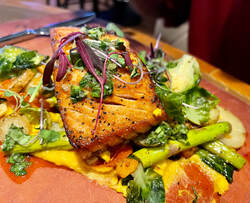
Dietary fats are oily, smooth in texture, and have a creamy mouth feel. They are very satisfying to the tongue and tummy. Fats are very satiating, which means after a fatty meal, we can go for a long time before we become hungry again. Some foods containing fats are nuts, seeds and their oils, meats and their skins, rendered lard or tallow, fish and seafood, olives and their oil, avocados and their oils, and dairy.
Fats slow down the absorption of the foods eaten alongside of them as well, helping the body absorb at a higher rate the vitamins, minerals, and phytochemicals in those foods. The term we use for the vitamins, minerals, and phytochemicals in our food supply is called micronutrients.
Carbohydrates are the rapid energy givers in our food. Carbohydrates come from fruits, vegetables (both starchy and non-starchy), grains, beans, dairy, and sugars. The textures in carbohydrates can vary wildly, and so can the fiber content. All carbohydrates break down into glucose sugar during digestion. Then our body knows to use it as energy. The glucose further turns into glycogen, which is then stored in our muscle cells for active use. Our body breaks down a candy bar, a glass of orange juice, and a bowl of cabbage into glucose. The difference between the rate of even, balanced energy in the body versus a spike of energy and then a crash, is the amount of fiber in the carbohydrate source. Fiber slows down the rate of absorption and transference into energy. This is better for regulating the body’s supply of energy. We can usually tell after eating each food type whether we feel tired or ready to take on the world.
Proteins are the muscle builders in our food. They are made up of amino acids, some of which our body can make, and others which our body cannot make. The amino acids our body cannot make we must get from food. They are called essential amino acids. Protein is found in meat, fish, seafood, nuts, seeds, dairy, and some fruits and vegetables. If we consume more protein that our body needs for fuel, the protein can convert into glucose. This is called gluconeogenesis.
As you may have noticed, some foods cross over into more than one category. A slice of cheddar cheese contains fats, carbohydrates, and protein. Black beans are thought to be a great source of protein, but a closer look reveals that they only contain about thirty percent protein. The rest is carbohydrates and fat. Then we must determine what percentage of that protein can actually be absorbed and used by the body. This absorption rate is called bioavailability. Nuts are another food source that have all three basic components in them.
A fun activity that the family can play around with is to list the most typically recognized foods in each category and then decide together which foods have more than one macronutrient in them.
All three components are vital for people to be well at any age. Excess fats, carbohydrates, and proteins can lead to body fat. That is, if you consume obscene amounts of food daily, your body must store the extra fuel somewhere, usually on the hips, thighs, and abdomen. If one is consuming refined, processed foods, convenience foods, and junk foods with little nutrient density, the process occurs rapidly and easily. Our bodies do not know what to do with the unnatural edible food “wannabes.” Real, whole foods slow down the digestion and absorption rate, therefore providing the body with what it needs to thrive. Doesn’t that sound good?
Be well,
KJLandis
SuperiorSelf on YouTube

 RSS Feed
RSS Feed